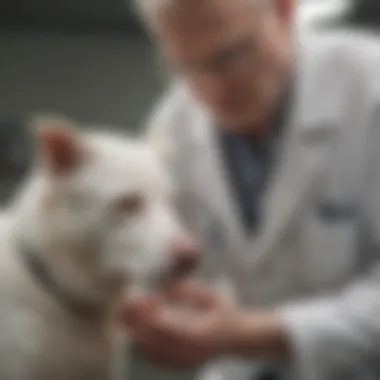Exploring Albino Dogs for Sale: Unique Traits & Care


Intro
Albino dogs often evoke curiosity and fascination among dog lovers and prospective owners. Their distinct physical appearance stems from a genetic condition known as albinism, characterized by a lack of pigmentation. This condition can lead to unique attributes and challenges. The prospect of purchasing an albino dog raises numerous questions about their traits, health considerations, and ethical breeding practices.
This article aims to provide a comprehensive guide concerning the nuances of owning an albino dog. By delving deep into their unique characteristics, potential health concerns, and the complexities of breeding, individuals can arm themselves with insights necessary for informed decisions.
The market for albino dogs may seem niche, but it is essential to comprehend the factors influencing it. Issues such as ethical breeding methods and the welfare of these animals are paramount to ensuring that future owners engage responsibly.
A thorough understanding not only enhances the experience of ownership but fosters a greater respect for the challenges associated with these distinctive breeds. From the marketplace dynamics to the intricacies of caring for an albino dog, this exploration endeavors to illuminate the path for those considering this exceptional choice.
Intro to Albino Dogs
Albino dogs are a fascinating topic that raises questions about genetics, breeding practices, and animal welfare. Understanding these unique canines is essential for anyone considering ownership or involvement in breeding. The importance of this section lies in establishing a baseline of knowledge. This comprehension not only aids prospective owners in making informed decisions but also enhances awareness among breeders and advocates of animal welfare.
Definition of Albino Dogs
Albino dogs are characterized by a complete lack of pigmentation in their coats, skin, and eyes. This phenomenon is a result of genetic mutations that impede melanin production. The absence of this pigment leads to a striking appearance: their fur often appears stark white, and their eyes can be light blue or even pink, granting them a distinct look among canine breeds. Understanding this definition is crucial as it lays the groundwork for comprehending the implications of owning an albino dog, including health and environmental considerations.
Common Breeds Exhibiting Albinism
Several dog breeds may exhibit albinism, though it is relatively rare. Notable breeds include the Chihuahua, Dachshund, and Boxer. Each breed exhibits unique characteristics, yet all share the common trait of lacking pigment.
- Chihuahua: Often recognized for their small size, Chihuahuas can display albinism. They are usually lively and loyal.
- Dachshund: Known for their elongated bodies, some Dachshunds exhibit albino traits, which can lead to particular health concerns.
- Boxer: This breed exhibits a strong and muscular build, but albino Boxers may face more significant health challenges due to their genetic background.
Awareness of these breeds allows potential owners to understand the breadth of options available and to consider the specific care requirements or potential health issues associated with albinism. Choosing the right breed requires careful consideration, taking into account both appearance and health aspects.
Understanding Albinism in Dogs
Understanding albinism in dogs is crucial for a few reasons. It not only touches on the genetics involved but also addresses the physical characteristics that make albino dogs unique. Grasping these elements helps potential owners and breeders appreciate what it means to care for these dogs. Albino dogs possess features that can influence their health, welfare, and the general perceptions of these unique animals in society. An informed understanding can lead to better choices in terms of care, ethical breeding, and management of potential health issues.
Genetic Basis of Albinism
Albinism in dogs is largely the result of a genetic mutation affecting the production of melanin. Melanin is responsible for the pigmentation in skin, hair, and eyes. The primary gene associated with albinism is the TYR gene. A mutation in this gene leads to a reduction or absence of pigment. This condition can occur in several dog breeds, allowing for a fascinating examination of how genetics shapes appearance and health. Owners must be aware that the genetic background of their pet may predispose them to various health issues.
Physical Characteristics of Albino Dogs
Examining the physical characteristics of albino dogs provides deeper insight into their care needs and lifestyle considerations.
Coat Color
The coat of an albino dog is typically white or very pale due to the lack of pigmentation. This unique coat color can make these dogs visually striking. However, it also presents some challenges. The lack of melanin means that the coat does not offer the same level of protection from the sun as pigment-rich fur. Owners should ensure their dogs have shade and protection from direct sunlight, as prolonged exposure can lead to skin problems.
Eye Color


Albino dogs often have light blue or purple eyes. This striking eye color results from their limited melanin production. While aesthetically appealing, the light eye color may be associated with vision problems, including sensitivity to light. Owners should observe their dogs for signs of discomfort in bright lighting conditions. Regular veterinary check-ups can help in monitoring their eye health.
Skin Sensitivity
Skin sensitivity is a significant concern for albino dogs. With reduced melanin, their skin is more vulnerable to sunburn and other dermatological issues. It is essential for owners to take steps such as applying appropriate sunscreen designed for animals or using protective clothing during walks. Recognizing this sensitivity is critical for maintaining their overall health and comfort.
Understanding these physical characteristics enhances the ability to provide optimal care for albino dogs, ensuring they live happy and healthy lives.
Being informed about these unique features not only enriches the owner’s experience but also contributes to the wellbeing of the dogs themselves.
Ethical Considerations in Breeding Albino Dogs
Breeding albino dogs raises numerous ethical questions that are crucial for prospective owners and breeders. It is vital to consider the implications of selective breeding practices that target specific traits associated with albinism. Each choice made in the breeding process carries potential consequences for the health and well-being of the animals involved. Therefore, a thorough examination of these ethical considerations helps in promoting responsible ownership and breeding.
Selective Breeding Practices
Selective breeding can sometimes lead to a focus on aesthetic qualities rather than the health of the dogs. When breeders prioritize traits like coat color and eye appearance, they may unintentionally overlook the genetic health of these individuals.
- Focus on Appearance: The appeal of albino dogs might entice owners, often leading breeders to emphasize the unique visual characteristics. This approach could exacerbate underlying health issues.
- Genetic Diversity: It is essential for breeders to maintain genetic diversity. A narrow focus on just the traits associated with albinism can lead to inbreeding. This practice increases vulnerability to various health problems.
- Health Screening: Responsible breeding should always involve health screenings. Ensuring potential breeding pairs are evaluated for hereditary conditions is crucial. By prioritizing health alongside appearance, the breeding community can mitigate some risks associated with albinism.
This delicate balance of aesthetics and health in selective breeding is significant for the future of albino dogs.
Impact on Animal Welfare
The welfare of albino dogs is impacted greatly by breeding choices. Being aware of potential shortcomings in care can guide owners and breeders to act in the best interests of these dogs.
- Health Risks: Albino dogs are predisposed to specific health issues such as vision problems or skin sensitivities. If breeders do not consider these factors, the animals may suffer undue distress and medical problems.
- Lifespan and Quality of Life: Responsible breeding practices can improve the overall quality of life for albino dogs. Awareness of common health issues can help ensure that prospective buyers understand the commitment required.
- Ethical Adoption: Finding a suitable home for albino dogs can be more challenging. Some buyers may overlook them due to misconceptions about their health or needs. Animal welfare advocates stress the importance of ethical adoption practices. By ensuring these dogs find loving homes, we can enhance their quality of life.
"Ethical breeding practices are essential to prevent the suffering of dogs that may be affected by health issues due to aesthetic-focused breeding."
Health Issues Associated with Albino Dogs
The topic of health issues associated with albino dogs is crucial to understanding their overall well-being and requirements. These dogs, due to their unique genetic composition, face a range of potential health complications. Recognizing these issues allows prospective owners and breeders to take necessary precautions and ensure proper care. It also highlights the importance of responsible breeding practices that prioritize the health of the animal over aesthetic desires.
Vision Problems
Albino dogs often suffer from vision-related issues. Due to the lack of pigmentation in their eyes, many experience conditions such as strabismus (crossed eyes) or nystagmus (involuntary eye movement). They might also be sensitive to bright light, making it difficult for them to function in well-lit environments. This can lead to a condition called photophobia, causing discomfort or disorientation when exposed to sunlight. Owners should take measures to ensure that these dogs have shaded areas to retreat to. Regular eye check-ups with a veterinarian are also essential for monitoring any potential deterioration in their vision.
Skin Disorders
Skin disorders are another significant concern for albino dogs. Their lack of pigment makes their skin more susceptible to sun damage and conditions such as sunburn, which can lead to further complications like skin infections or cancer. Protective measures, such as applying pet-safe sunscreen and limiting sun exposure, are recommended. It is also important for owners to maintain a consistent grooming routine to prevent skin irritations or infections caused by dirt and allergens. Regular veterinary visits can help catch any early signs of skin issues, ensuring timely treatment and intervention.
Hearing Impairments
Hearing impairments are quite common among albino dogs, linking closely to their genetic makeup. Some breeds are inherently predisposed to deafness, and the lack of melanin can exacerbate these issues. While not all albino dogs will face hearing difficulties, a significant percentage may have some level of impairment. This can affect their ability to respond to commands or interact socially. Prospective owners should ensure they are prepared to employ alternative training methods, such as hand signals or tactile cues, to communicate effectively with their dog. Regular veterinary assessments can also aid in determining the extent of any hearing loss and help owners respond appropriately.


Important Note: Understanding these health issues associated with albino dogs is vital. Taking proactive steps can greatly improve their quality of life and enhance the bond between the dog and owner.
Addressing the health challenges faced by albino dogs is essential to ensure their well-being. Prospective owners must be informed and prepared for the unique healthcare needs of these dogs.
Market Insights on Albino Dogs
Understanding the market dynamics surrounding albino dogs is crucial for prospective owners and breeders alike. This segment will outline current trends and pricing dynamics that define the marketplace for these unique breeds. Insights from market research can inform individuals about the demand and supply of albino dogs, shedding light on ethical breeding practices and animal welfare considerations.
Current Trends in the Market
The popularity of albino dogs has seen fluctuations in recent years. One notable trend is the increasing awareness of albinism and its associated characteristics. Owners and breeders are focusing more on responsible breeding practices that prioritize health and welfare of the dogs. Moreover, social media platforms like Facebook and Reddit play a significant role in raising awareness. Many breeds, such as Dogo Argentino and American Bully, are gaining attention due to their striking appearance and personality traits.
Additionally, there's a rising trend of adopting albino dogs from shelters instead of purchasing from breeders. This shift indicates a broader societal movement towards rescuing pets and giving second chances to animals in need. Adoption programs often highlight the uniqueness of albino dogs, which makes them more appealing to potential owners.
Pricing Dynamics
Price points for albino dogs can vary significantly based on several factors. On average, an albino dog can cost anywhere from $500 to $3,000.
Factors affecting cost include:
- Breed type: Certain breeds are more desirable and, as a result, command higher prices. For instance, breeds like the American Bully can sell for much higher compared to a mixed breed.
- Pedigree and lineage: Proven lineage and show-quality dogs often fetch a premium.
- Health screening: Well-bred albino dogs are typically subject to health screenings for genetic issues, which may increase their initial price.
It is important to note that while purchasing from reputable breeders tends to be more expensive, it often results in better health and temperament of the dog. The commitment to ethical breeding practices ensures that potential health issues common to albino dogs are minimized. In the long run, investing more upfront may save money in veterinary bills and improve the quality of life for the dog.
"Investing in high-quality breeding can prevent future health problems that commonly occur with albinism."
Sources for Purchasing Albino Dogs
Finding the right source for purchasing albino dogs is crucial for ensuring quality and ethical considerations are met. Prospective owners must navigate a landscape filled with various options, each with distinct advantages and drawbacks. Understanding where to find these dogs not only aids in better decision-making but also contributes to responsible pet ownership. Choosing the right source can lead to healthier, well-adjusted dogs and can support ethical breeding practices.
Reputable Breeders
When considering acquiring an albino dog, reputable breeders are often the most reliable source. They typically possess a deep knowledge of the breed and the specific traits associated with albinism. Furthermore, they tend to adhere to ethical breeding guidelines that prioritize the health and well-being of the animals.
Some characteristics to look for in reputable breeders include:
- Transparency: A good breeder should be willing to share information about their breeding practices, the lineage of the dogs, and any health screenings that have been conducted.
- Health Guarantees: Reputable breeders often provide health guarantees for their dogs, indicating their commitment to ensuring that the dogs are free from genetic disorders.
- Socialization: Early socialization is critical for a dog’s development. Ensuring that dogs are raised in a nurturing environment can lead to well-adjusted pets.
Moreover, prospective owners can often find positive reviews and testimonials from previous clients, which can serve as an excellent indicator of a breeder's reliability.
Adoption Programs and Shelters
Another valid option for acquiring an albino dog is through adoption programs and shelters. Many dogs in shelters are in need of homes. Some of these dogs may be albino, and adopting them not only provides a loving home but also promotes animal welfare.
Adopting from shelters has several benefits:


- Cost Efficiency: Adoption fees at shelters are generally lower than purchasing from breeders. The fee often includes vaccinations and an initial health check.
- Saving Lives: By adopting, individuals help reduce the number of homeless dogs in shelters.
- Support: Many shelters also offer support and advice for new dog owners, which can be invaluable for first-time pet parents.
For those interested in adopting, researching local shelters and rescue groups that specifically focus on albino or special needs dogs can yield great results. Websites like Petfinder can also help prospective owners locate available dogs in their area.
In summary, whether opting for a reputable breeder or choosing to adopt from a shelter, it is crucial for potential owners to conduct thorough research. The aim should be to find an ethical source that prioritizes the health and well-being of the dogs.
Caring for Albino Dogs
Caring for albino dogs requires a specialized approach. These dogs have unique needs primarily due to their genetic traits. Understanding these requirements is crucial for ensuring the well-being of albino dogs. This section outlines the dietary needs and routine medical care specific to them. Taking proper care of these unique breeds can significantly enhance their quality of life and longevity.
Dietary Needs
Albino dogs often have specific dietary requirements that cater to their sensitive conditions. Proper nutrition plays a vital role in maintaining their overall health. A balanced diet rich in vitamins and minerals is essential. It is advisable to consult with a veterinarian to devise a suitable diet plan. Some key points to consider include:
- High-quality protein sources: Important for muscle development and overall health.
- Omega fatty acids: Support skin health and coat quality, crucial for albino dogs.
- Antioxidants: These help to combat inflammation and strengthen the immune system.
Selecting dog food that lists these ingredients is a wise approach. Be cautious about food allergies, as albino dogs can be more sensitive to particular ingredients.
Routine Medical Care
Routine medical care is fundamental for the health and well-being of albino dogs. This includes regular vet check-ups and an appropriate vaccination schedule. Both aspects ensure early detection and treatment of any health concerns that may arise.
Regular Vet Check-ups
Regular vet check-ups are vital in monitoring an albino dog's health status. It allows for the identification of potential health issues before they become serious. This proactive care can ultimately extend the life of the dog. Key characteristics of regular vet check-ups include:
- Preventive care: A vet can identify warning signs before they progress.
- Tailored health advice: Vets can provide personalized guidance based on your dog’s unique needs.
- Dental health assessments: Oral hygiene is crucial for overall health, especially in breeds prone to dental issues.
The unique feature of regular check-ups is that they foster a continuous relationship between the owner and the veterinarian. This relationship helps in making informed health decisions for the dog.
Vaccination Schedule
A structured vaccination schedule is imperative for albino dogs. Vaccinations safeguard against various infectious diseases. They strengthen the immune system, making it robust. Important aspects to include about vaccination schedules are:
- Core vaccinations: Protect against serious ailments, such as parvovirus and rabies.
- Timing: Keeping to the recommended schedule ensures maximum protection.
- Boosters: Vaccination boosters maintain diluted immunity, which can wane over time.
The unique advantage of a well-organized vaccination schedule lies in its ability to offer peace of mind. Knowing your albino dog is protected against common diseases alleviates stress for the owner.
By prioritizing dietary needs and routine medical care, owners can enhance the lives of albino dogs significantly. These efforts not only prolong their life but also enrich their quality of life.
End
In examining the various elements associated with albino dogs, we conclude that understanding this topic is crucial for anyone considering ownership or breeding. The unique characteristics of albino dogs set them apart. However, as with any pet, responsible ownership comes with its own challenges. This includes genetic considerations, health issues, and ethical breeding practices. It is important for potential owners to be fully informed before making a commitment.
Summary of Key Points
- Definition and Breeds: Albino dogs are not defined by a single breed; several breeds exhibit albinism, characterized by their unique coloration. Such traits bring both aesthetic appeal and responsibility.
- Health Considerations: Vision problems, skin disorders, and hearing impairments are common health issues faced by albino dogs. Awareness of these is necessary for proper care.
- Market Trends: The demand for albino dogs has unique pricing dynamics. Understanding these trends can aid in making informed decisions regarding purchasing.
- Caring Responsibilities: Special attention is needed for diet and routine medical care. Regular veterinary check-ups and vaccinations are essential for their well-being.
- Ethical Breeding: Being aware of the implications of selective breeding practices is vital for maintaining animal welfare. It can shape the future of albinism in specific breeds.
Final Thoughts on Ownership
Owning an albino dog can be rewarding but requires careful consideration. Their striking appearance may attract many, yet underlying health issues need focused management. Prospective owners should prioritize research into the specific breed's needs and health challenges. This will not only enhance the dog’s quality of life but also fulfill the owner's responsibilities towards animal welfare. Abiding by these considerations, individuals can enjoy a fulfilling relationship with their albino pets, ensuring their health and happiness for years to come.







